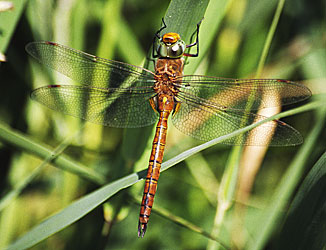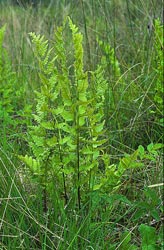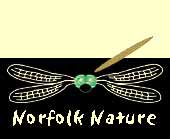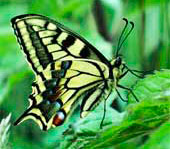Once a vast estuary, it was the extraction of peat to feed the fires of mediaeval Norwich that created the Norfolk Broads. The Broads themselves started life as shallow, steep-sided pits beside the rivers. Peat extraction came to an end as water levels rose and the pits were flooded, but the marshes remained a valuable resource for local people. Norfolk Hawker |
 |
| It was the hand of man that created the Broads, and the continued collection of reed and sedge for thatching, the cutting of ‘marsh hay’ and extensive grazing all playing a part in maintaining the landscape. The wild, lonely expanses of the Broads became known as a haven for wildlife, and more recently they have became a playground for those who love to mess around in boats. |
 |
The sight of a boat in full sail, gliding across the flat expanse of a grazing marsh, is the epitome of a Broadland scene. |
| Sadly, during the latter half of the 20th century, a combination of disturbance, the abandonment of traditional land uses and nutrient-rich run-off from fields and sewage works led to a serious decline in the wildlife interest of the Broads, with signature birds such as the Bittern disappearing from the area. Happily, there has been some recovery, not least because of hard work by the Norfolk Wildlife Trust, RSPB, Broads Authority and other conservation bodies. The waters are cleaner, tourism is more regulated and in the summer months the Broads are alive with wildlife, especially if you know where to look. |
Most of the more interesting plants in Broadland are found in the riverside marshes and in the dykes that criss-cross the grazing marshes. Typical plants of the "tall-herb fen" include Common Reed, Meadowsweet, Hemp Agrimony and Purple and Yellow Loosestrifes, with local specialities including Marsh Fern, Cowbane, Greater Water-parsnip, Greater Spearwort, Marsh-pea and the statuesque Marsh Sow-thistle. Areas of shorter fenland vegetation may be bright with Southern Marsh Orchids as well as the occasional Early Marsh Orchid and a variety of sedges and rushes, with here and there some much scarcer species such as Round-leaved Wintergreen. Crested Buckler-fern |
 |
Bisecting the fens and grazing marshes the cleaner dykes support a varied and interesting flora, with Frogbit, Arrowhead, Greater Bladderwort, Water Soldier, and Fringed, Yellow and White Water-lilies. The processes of natural succession put on a burst of speed once grazing and cutting have been abandoned and wet carr woodland takes over. Perhaps the closest thing to a ‘jungle’ in Britain, deep sloppy peat is punctuated by willows, Alders and Greater Tussock-sedge. Access to these areas would be well-nigh impossible but for the provision of boardwalks at several reserves. Here, the stately Royal Fern can be found together with the much scarcer Crested Buckler Fern, a Red Data Book Species and another Norfolk speciality. It is not just the wild flowers and other plants that have made the Broads famous. The glamorous Swallowtail butterfly is unique to the Broads, and the Norfolk Hawker dragonfly is more-or-less confined to east Norfolk too; given clement weather, we should have no problem in finding these ‘must-see’ species at the right time of year. Of the birds, Cetti’s Warbler is now common, although always hard to see, and in the early summer the sky is seldom without a Marsh Harrier or two. |


